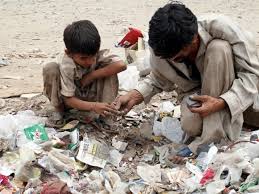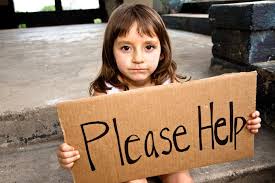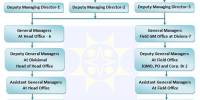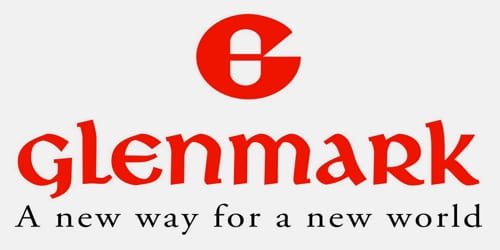Role of Micro-credit on Poverty in Bangladesh:
Bangladesh has experienced rapid growth in the micro-credit sector since 1990. Prior to 1990, only a handful of organisations were in operation. Many NGOs adopted and built on the experience of the Grameen Bank. Some of these NGOs experimented with the Grameen Bank micro-credit delivery system at the beginning and gradually they developed their own micro-credit delivery system (such as BRAC and ASA, see below). Currently, more than 1,000 NGOs operate micro-credit programmes in Bangladesh (see Rahman, 1999). The contribution of many of these NGOS to micro-credit disbursement is very small. For example, a study of 369 NGOs indicates that the top three NGOs as of June, 1998: held 69 per cent of total credit; held 83 per cent of total net savings; held 85 per cent of cumulative credit; held 82 per cent of outstanding loans; and captured 71 per cent of the total revolving fund (see Rahman 1999). Most of the micro-credit institutions follow the flat rate method in calculating total interest. A very small number follow the declining method in calculating total interest. Under the flat rate method, NGOs charge interest rates typically between 10 to 30 per cent.
The empirical analysis presented below is based on data collected for three organisations involved in micro-credit activities in Bangladesh: (1) the Grameen Bank; (2) the Bangladesh Rural Advancement Committee (BRAC); and (3) the Association of Social Advancement (ASA). Table 1 presents some comparative information relating to the activities of these three organisations.
The Grameen Bank evolved from research project aimed at identifying the causes of poverty carried out by Professor Muhammad Yunus. He found that capital constraints had been forcing women to sell their handicraft products to input providers at prices that were much lower than market prices. He concluded that a lack of small-scale capital in rural areas, needed for income-generating activities, was one of the main causes of poverty. This experience led him to experiment with a loan program targeted at poor people without collateral. In 1983, through a government statute, the Grameen Bank became an official financial institution. It is now regulated by the Central Bank of Bangladesh, and is the largest player in the micro-credit sector. The Grameen Bank receives funds from both the Central Bank and commercial banks (about 75 per cent of the total), along with contributions from international donors.
The Grameen Bank pioneered (and continues to employ) the “group-lending model”. Five people with similar socio-economic status (usually from the same village), form a “group”. Each member presents himself or herself as a guarantor of other members’ loans. This system of “joint liability” replaces the more traditional collateral system used in the formal financial sector. If any member defaults the whole group becomes ineligible to receive additional loans. In this sense, each member of the group is responsible and liable for other members’ repayment of loans. Loans are repaid in weekly instalments, with each instalment being equal to 2 per cent of the principal.
In 2000, membership in the Grameen Bank was about 2.3 million, with a cumulative loan disbursement of about $3.2 billion. It operates in over 40,000 villages, covering nearly half of the total land area of Bangladesh. In 2000, members had a total savings balance of $83.2 million, and the recovery rate of was near 89 per cent (see Table 1). Currently, in terms of cumulative loan disbursement the Grameen Bank is the largest micro-credit organisation in Bangladesh.
After independence in 1971, the Bangladesh Rural Advancement Committee (BRAC) was established. Initially its main objective was to conduct relief and rehabilitation programmes. It continued to widen its activities and in 1976 established a micro-credit programme. At present it is prominent among the biggest NGOs in terms of development and micro-credit activities. BRAC started its micro-credit programme in 1976. Its current programme was initiated in 1990 and is known as the “Rural Credit Project”. BRAC’s other development activities include free informal education and heath and medical facilities to low-income people in rural areas. In 2002, membership in BRAC was about 3.9 million, with a total loan disbursement of about $1 billion. In 2000 the cumulative savings of BRAC stood at $65 million. In the same year it achieved a recovery rate of 98.4%. Currently, BRAC is the second largest micro-credit organisation in Bangladesh.
The Association of Social Advancement (ASA) was established in 1978. It began its micro-credit programme in 1991. Currently, ASA is the third largest micro-credit organisation in Bangladesh. It has developed a less expensive model for the implementation of savings and credit program, which has helped it become a more cost effective and sustainable program (Jain, 1999; Rutherford, 1995). Kalily, Imam and Khan (2000) conclude that ASA is more cost effective and more sustainable than the Grameen Bank. By 2000, ASA had extended credit to poor people in 22,740 villages out of approximately 86,000 villages in Bangladesh. The total number of members of ASA in 2000 was 1.2 million. In the same year the cumulative loan disbursement and cumulative savings of members stood at $466 million and $97 million respectively. In 2000 the recovery rate of ASA was 99.9%.
Sample Survey:
The analysis reported below is based on a household-level survey of micro-credit programme participants carried out from January to May 1999 (N = 954 households). The data was collected through face-to-face interviews following a four stage sampling design. Bangladesh is divided into 64 administrative districts. Two criteria were used to reduce the number of eligible districts. The first was that it had to one of those relatively close to Dhaka. This restriction was imposed simply because of time and budget constraints. The second was that the district was not one severely affected by the 1998 flood. This restriction was imposed because the devastation and deprivation created by this tragic event would mask any underlying impact of micro-credit. These criteria narrowed the number of eligible districts down to five, of which one, Comilla, was selected. Comilla lies about 70 km south-east of Dhaka and has a mainly rural population of about five million inhabitants.
In the second stage, a list of the “branches” of Grameen Bank, BRAC and ASA in Comilla was constructed. A branch usually consists of 50 to 60 “centres”, with each centre having 30 to 50 members. From this list, branches that had been in existence for at least eight years were selected. This restriction resulted in four branches of the Grameen Bank being identified, of which two were randomly selected. No branch of BRAC or ASA met this duration criterion. However, there were seven branches that had been in existence for five or more years (four BRAC and three ASA). From this group, one BRAC and one ASA branch was randomly selected. The two Grameen Bank branches were about 4.5 km away from Comilla Town. This distance was used as a selection criterion to choose a newly-established branch (i.e. in existence for less than one year) for some comparative work not reported in this paper. Only one branch met this criterion and was selected. In the third stage, centres were selected from these five branches. In each of the “old” (8+ years) Grameen branches there were 60 branches, from which 27 were randomly selected. In the “new” Grameen branch (less than one year old) there were 26 centres from which 20 were randomly selected. The BRAC and ASA branches each had 50 centres from which 35 were randomly selected. In total, 144 centres were selected from a total of 246.
In the fourth and final stage of sampling, individual households were selected. Lists of member households were obtained from each of the branch offices. As mentioned above, we are particularly interested in the impact of programme duration. Therefore, longer duration households were over-sampled. The households on these lists were grouped into four duration categories: (1) Less than two years; (2) 2-4 years; (3) 5-7 years; and (4) 8+ years. In the case of the two “old” Grameen branches, two households were randomly selected from each duration category. This resulted in 216 households from each branch, or 432 “old” Grameen households in total being included in the sample (i.e. 2 branches x 27 centres per branch x 4 duration categories x 2 households per duration category). Since member households of the newly-established Grameen branch by definition have durations less than one year, simple random sampling was used to select five households from each of the 20 centres, resulting in 100 “new” Grameen households being included in the sample. None of the BRAC and ASA branches had been in existence for eight years. For both, two households were randomly selected from each of three remaining duration categories. This resulted in 210 households from each branch being included in the sample (i.e. 35 centres x 3 duration categories x 2 households per duration category).
The sample consisted of 952 households. In total, information was collected for 432 member households of two “old” branches of Grameen; for 100 member households of a “new” branch of Grameen; and for 210 member households for a branch each of BRAC and ASA. Because of missing information on some of the key variables, 43 households had to be dropped, which reduced the size of the useable sample to 909 households. Table 2 (Column 1) presents some descriptive information relating to the sample. If we classify “new members” as those households who have been a member of a micro-credit programme for less than one year, then such cases make up 29.2% (N=265) of the sample. It is also important to note that 17% (N = 45) of these new members had not at time of the interview received the cash for the loan that had been agreed (although this was expected shortly). “Old members” (i.e. households with programme duration greater than one year) make up 70.8% (N = 644) of the sample. Given the sample strategy followed, it is difficult to judge how representative it is. However, it is our belief the information collected does capture the diversity of the micro-credit experience in Bangladesh and at the same time provides a meaningful vehicle for exploring how programme duration impacts on poverty.
Table 2 Objective and Subjective Poverty Rates
| |||
(1) | (2) | (3) | |
| Objective Poverty | Subjective Poverty | |
| Sample | N | PO | PS |
| “New” Members: | |||
Loan not received | 45 | 68.9% | 86.7% |
Duration < 1 year | 220 | 55.3% | 90.9% |
| Sub-total: | 265 | 65.3% | 90.2% |
| “Old” Members: | |||
Duration 1-2 years | 103 | 55.3% | 64.1% |
Duration 2-4 years | 214 | 54.2% | 52.3% |
Duration 5-7 years | 300 | 46.3% | 39.0% |
Duration 8+ years | 27 | 40.7% | 48.1% |
Sub-total: | 644 | 50.2% | 47.9% |
| TOTAL: | 909 | 54.6% | 60.2% |
The survey collected detail information on a variety of factors. For example, demographic information (age, sex, marital status, etc.) and socio-economic information (education, employment, food consumption, expenditure on health, etc.) was collected for all household members. Detailed village-level information was also collected, such as distance to nearest primary school, secondary school, market and district headquarters, along with variables describing village infrastructure, such as the presence of schools, markets, irrigation systems, roads, electricity, etc. Information relating to the size of loan received, date of joining and other membership characteristics was provided by branch officials and matched to the data.
As mentioned above, two poverty lines are used. The first is an objective poverty line. It is based on the cost associated with obtaining a minimum daily “adult” requirement of 2,112 calories (including 58 grams of protein). Equivalence scales were used (GOB, 1998) to adjust this amount for age differences, with the age-specific weights being: age 0-3=0.41; age 3-6=0.53; age 6-9=0.67; age 9-12=0.86; age 12-17=0.94; age 17-29=1.0; age 29-59=0.94 and age 59+=0.83. This implies a poverty line of 147 Taka per week, or about $US2.75 per week. The second is a subjective poverty line. A household was defined as being poor if the household head answered “yes” to the following question: “Do you consider your family poor based on your current yearly income?”
Table 2 shows the rates of poverty based on these poverty lines (columns 2 and 3). For the entire sample, the objective poverty rate (Po) is 54.6 per cent with the subjective poverty rate (Ps) being higher at 60.2 per cent. It is also important to note that there is a clear poverty differential between “new” and “old” members. The Po rate for new members is 65.3 per cent compared to 50.2 per cent for old members. Likewise the Ps rate for new members is 90.2 per cent compared to 47.9 per cent for old members. Taken at face value, these simple summary statistics suggest that both objective and subjective poverty is lower amongst those who have received micro-credit.
Examination of the summary statistics presented in Table 2 also suggests that both objective and subjective poverty decline with programme duration. Fitting a linear trend line in programme duration suggests that objective poverty falls by about 2.5 per cent per programme year. Likewise, subjective poverty falls by about 6.5 per cent per programme year. Although this provides some evidence that poverty appears to fall with programme duration, these estimates do not take into consideration other factors that might determine poverty. It is therefore necessary to control for these other factors before the impact of micro-credit can be gauged with increased confidence.
Statistical Model:
In order to control for some of these factors, logit regression is used. This model is of the general form:
Prob (P=1) = ¦(XP, XH, XV)
where: “P” is a dummy variable coded “1” if the household is poor and coded “0” if not; “XP”is a vector of micro-credit programme variables; “XH” is a vector of household and individual socio-economic characteristics; and “XV” is a vector of village-level characteristics. In the logit model “¦” follows a logistic distribution. The above model is estimated for both objective and subjective poverty.
This model is estimated using three different specifications of the micro-credit programme variables that attempt to capture the impact of programme duration on poverty. The first is a simple linear specification:
X1P = a1L + a2L×D
where “L” is a dummy variable coded “1” if the micro-credit loan has been received and coded “0” if not; and “D” is the length of time (measured in months) the household has been in receipt of micro-credit (months programme duration). The second is a quadratic specification:
X2P = a1L + a2L×D + a3L×D2
which will allow a test of non-linearity in the relationship between poverty and programme duration. The third specification replaces the programme duration variables with a series of dummy variables representing ten separate duration categories:
X3P = a1L + a2D6 + a3D12 + a4D24 + a5D36 + a6D48
+ a7D60 + a8D72 + a9D84 + a9D96 + a10D>96
where “D6”is a dummy variable coded “1” if programme duration is less than 6 months and coded “0” if not; “D12” is a dummy variable coded “1” if programme duration is between 7-12 months and coded “0” if not; etc.
It is important to note that the sample includes 45 “new member” households who had not at the time of the interview received their loan. That is, they had been applied for and had been selected for a loan but had not received the cash. One of the problems associated with evaluating the impact of micro-credit on poverty relates to the “self-selection” of programme participants (see Coleman, 1999). If programme participants are not a random sub-sample of the more general target population (i.e. the poor), then models estimated using information only on participants would likely lead to biased estimates of the impact of micro-credit on poverty. Including “new members” who have not yet received their loan, helps control for this selection bias, since we have little reason to believe that the factors that cause “new members” and “old members” to apply for a loan in the first place are somehow systematically different. At the same time, if the loan has not yet been received, we can safely assume that it cannot have a poverty-reduction impact. Statistically we can capture this effect by interacting the variable “L” (whether or not the loan has been received) with programme duration.
The other variables included in the regression equation are given in Table 3, along with means and standard deviations. The variables included in the vector of household and individual socio-economic characteristics (XH) are religion, land ownership, education and the demographic composition of the household. The variables included in the vector of village-level characteristics (XV) are the presence of a primary school, a secondary school, a tube well and electricity in the village, along with the distance to the nearest market, paved road, commercial bank, district headquarters and Dhaka. Dummy variables for geographic region are also included.
Table 3 cont’d
| |||
| DisDhaka | Distance from household to Dhaka (kilometres) | 42.6 | 18.9 |
|
| ||
| Area1 | Dummy coded “1” for Sholownol Burichong area and “0” otherwise. | 20.1% | — |
| Area2 | Dummy coded “1” for Jagat Pur area and “0” otherwise. | 4.4% | — |
| Area3 | Dummy coded “1” for East Gouri Pur area and “0” otherwise. | 21.6% | — |
| Area4 | Dummy coded “1” for West Gouri Pur area and “0” otherwise. | 23.8% | — |
| Area5 | Dummy coded “1” for Chandina area and “0” otherwise. | 19.1% | — |
| Area6 | Dummy coded “1” for Bijoy Pur area and “0” otherwise. | 11.0% | — |
Table 3 Variables used in Analysis
| |||
Mnemonic
|
Definition |
Mean | Standard deviation |
Poverty variables:
| |||
| Po | Objective poverty (see text) | 54.6% | — |
| Ps | Subjective poverty (see text) | 60.2% | — |
Programme variables :
| |||
| L | Dummy variable coded “1” if household has received a loan and “0” if not. | 95.1% | — |
| D | Programme membership duration (months) | 41.5 | 31.7 |
Socio-economic variables:
| |||
| Religion | Dummy variable coded “1” if household belongs to Islam and “0” if not | 90.1% | — |
| Land | Total area of agricultural land owned by household before membership in programme (Khatas: 100 Khatas =1 hectare) | 23.2 | 41.6 |
| EF | Highest education of female household member (years of schooling) | 4.1 | 3.5 |
| EM | Highest education of male household member (years of schooling) | 5.3 | 4.1 |
| Household composition variables:
| |||
| Fem(<5) | Number of female household members under age 5 | 0.26 | 0.49 |
| Fem(5-15) | Number of female household members aged 5 to 15 | 0.91 | 0.99 |
| Fem(16-24) | Number of female household members aged 16 to 24 | 0.33 | 0.55 |
| Fem(25-39) | Number of female household members aged 25 to 39 | 0.65 | 0.48 |
| Fem(40-59) | Number of female household members aged 40 to 59 | 0.24 | 0.43 |
| Fem(>60) | Number of female household members over age 60 | 0.05 | 0.21 |
Male(<5) | Number of male household members under age 5 | 0.26 | 0.51 |
Male(5-15) | Number of male household members aged 5 to 15 | 0.97 | 0.96 |
Male(16-24) | Number of male household members aged 16 to 24 | 0.42 | 0.69 |
Male(25-39) | Number of male household members aged 25 to 39 | 0.61 | 0.59 |
Male(40-59) | Number of male household members aged 40 to 59 | 0.46 | 0.50 |
Male(>60) | Number of male household members over age 60 | 0.07 | 0.26 |
| Village characteristics:
| |||
| PrimSch | Dummy coded “1” if primary school in village and “0” if not | 80.2% | — |
| SecSch | Dummy coded “1” if secondary school in village and “0” if not | 29.4% | — |
| TubeWell | Dummy coded “1” if village has a tube well and “0” if not | 62.9% | — |
| Electric | Dummy coded “1” if village has electricity and “0” if not | 80.4% | — |
| DisMarket | Distance from household to nearest market (kilometres) | 0.85 | 0.76 |
| DistRoad | Distance from household to nearest paved road (kilometres) | 0.77 | 0.88 |
| DisBank | Distance from household to nearest commercial bank branch (kilometres) | 1.7 | 1.3 |
| DistDHQ | Distance from household to district headquarters (kilometres) | 19.2 | 13.0 |
Results:
The key coefficients of the estimated logit equations are summarised in Table 4. Columns (1)-(3) are for objective poverty while Columns (4)-(6) are for subjective poverty. For brevity, only the coefficients for the variables included in the programme duration specifications are shown. The complete set of estimates is available from the authors upon request. From a statistical point of view, the coefficients are better determined for subjective poverty than for objective poverty (as indicated partially by the ratio of the coefficient to its standard error given in parentheses). It is also interesting to note that in none of the models is the “L” variable statistically significant at the conventional threshold levels, providing some evidence that selection bias may not be a problem. As a general remark, the estimates suggest that micro-credit does appear to be associated with lower objective and subjective poverty, with both poverty rates declining with programme duration.
Table 4 Logit Regression Equations Objective and Subjective Poverty
| ||||||
Objective Poverty (Po)
|
Subjective Poverty (Ps) | |||||
(1) | (2) | (3) | (4) | (5) | (6) | |
| Duration Spec:
|
Linear |
Quadratic |
Dummies |
Linear |
Quadratic |
Dummies |
| L | -0.220 [0.58] | -0.133 [0.32] | — | -0.643 [1.2] | -0.023 [0.1] | — |
| D | 0.009 [3.2] | -0.015 [1.3] | — | -0.022 [7.1] | -0.059 [4.5] | — |
| D2 | — | 0.061 [0.05] | — | — | 0.388 [3.0] | — |
| D6 | — | — | -0.118 [0.3] | — | — | -0.043 [0.1] |
| D7-12 | — | — | -0.070 [0.2] | — | — | 0.825 [1.2] |
| D13-24 | — | — | -0.339 [0.08] | — | — | -1.45 [2.6] |
| D25-36 | — | — | -0.691 [1.5] | — | — | -2.017 [3.4] |
| D37-48 | — | — | -1.016 [2.3] | — | — | -1.791 [3.1] |
| D49-60 | — | — | -0.485 [1.0] | — | — | -2.394 [4.0] |
| D61-72 | — | — | -0.885 [2.2] | — | — | 2.386 [4.4] |
| D73-84 | — | — | -0.821 [1.7] | — | — | -1.989 [3.4] |
| D85-96 | — | — | -0.875 [1.9] | — | — | -2.346 [4.0] |
| D>96 | — | — | -1.025 [1.7] | — | — | -2.214 [3.0] |
| Notes: (1) Ratio of coefficient to its standard error shown in parentheses. (2) Equations also include control variables shown in Table 3 but coefficients not reported.
| ||||||
In order to demonstrate this last finding more intuitively, Figures 1 and 2 show the relationship between poverty and programme implied by the estimates. Figure 1 is for objective poverty while Figure 2 is for subjective poverty. For convenience, programme duration is measured in years. Two steps were required to construct these “adjusted poverty” rates. In the first step, the estimated coefficients were used to “predict” each household’s poverty rate given each household’s individual values of the control variables given in Table 3. In the second step, these values were averaged across all households at progressively increasing programme durations in order to get duration-specific “mean” poverty rates that net-out the effects of other variables that affect poverty.


















